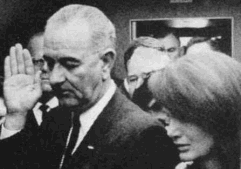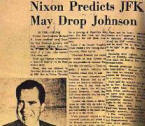Complicity of Intelligence Apparatus
In both cases, the federal
detective force (FBI and CIA in Kennedy's case) were warned in advance of
a plot to kill the president, and in both cases the warnings were
deliberately ignored by those in charge of security; Edwin Stanton and J.
Edgar Hoover, respectively.
In Lincoln's case Louis
Weichmann, a lodger at Mary Surrat's boarding house, reluctantly reported
to government officials in March of 1865 that he believed there was a
conspiracy afoot to kill Lincoln. He was ignored. But after the murder a
scapegoat was needed, and on the basis that Booth and conspirators met at
the boarding house, Mary Surrat was hanged.
In Kennedy's assassination,
FBI Director Hoover was personally alerted numerous times of a
plot to kill him in Dallas. A letter from the Oswald imposter to
Valery Kostikov of the Soviet Embassy in Mexico City was intercepted
November 9, 1963. Kostikov was the KGB officer in charge of assassinations
in the western hemisphere. Ironically, Lee Harvey Oswald tipped off the
FBI on September 17, 1963 that an assassination was being plotted. William
S. Walters, a security clerk employed in the Bureau's New Orleans office,
gave D.A. Jim Garrison an affidavit stating that on the morning of
November 17, 1963, he read a TWX that warned "an attempt to assassinate
President Kennedy would be made in Dallas on November 22, 1963."
When he was arrested,
Oswald had the name, telephone number, and license plate number of FBI
agent James Hosty. And after Kennedy was shot, Hosty was ordered to
destroy a note left to him by Oswald; which he tore up and flushed down
the toilet.
Nor did Hoover reveal that
Jack Ruby was also an informant for the FBI, as was Lee Harvey Oswald; who
was hired upon his return from Russia. Oswald was a double agent in
military intelligence-- that's why no charges were pressed against him for
his "defection." The Russians themselves were suspicious of him as he
walked into the Russian Embassy and denounced his citizenship, and offered
classified radar data.
Although it was claimed that Oswald
provided the information-- flight paths and altitudes, e.g., that led to
the downing of Gary Power's U-2 spy plane; U.S. authorities made no effort
to prosecute him upon his return. It's possible the Russians downed Powers
on their own with information provided by someone other than Oswald.
By
1963, a man claiming to be Oswald will offer to kill JFK in the Cuban Embassy in Mexico
City. The Mexican government will warn U.S. officials, and they will be
ignored. A man is photographed outside the embassy that day, and the man
that claims he is Oswald bears no resemblance. As an undercover "defector"
for the CIA, Oswald was the perfect patsy. The military-industrial
establishment wanted to launch a war with Cuba.
Lee Harvey Oswald was told
by intelligence officers that they wanted him to infiltrate a Communist
conspiracy to kill JFK in Dallas. His FBI contact, one of several,
was Special Agent in Charge James Hosty. To convince Castro sympathizers
and agents he was genuine, he was given airtime to promote the communist
agenda. A much publicized fight was staged between Oswald and
a so-called "angry patriot" as he handed out "Hands off Cuba" flyers.
When Kennedy was shot,
Hoover officially disowned Oswald. So in comes Jack Ruby, a mob
lackey and friend of the Dallas police chief.
To be fair, some in
the CIA were aware of the plot and rebelled against it. In Texas, on
September 20, 1963, three days after Oswald alerted the FBI of the plot,
Richard Case Nagell entered an El Paso bank and calmly shot holes in the
ceiling. Then he simply waited for the police to arrive. He said he wanted
to be in jail when Kennedy was assassinated. His registered letters to J.
Edgar Hoover which warned of the plot were read but not answered.9
police to arrive. He said he wanted
to be in jail when Kennedy was assassinated. His registered letters to J.
Edgar Hoover which warned of the plot were read but not answered.9
(According to Assistant FBI Director William Sullivan, Hoover took special
care to read all of his mail. For every letter received the sender or
organization was checked out in the FBI's Central Files before his staff
answered it. Thousands and thousands of man-hours were spent and millions
squandered on these background checks.)
Nagell
knew Oswald, having met him in Texas. What Nagell was hired to do, but
refused, was
"arrow", or kill, this patsy after setting him up for the shooting. This
job eventually went to Jack Ruby.



 Bravery Under Fire: Jim
Garrison
Bravery Under Fire: Jim
Garrison  The are Liars, Damned Liars, and then Gerald Posner...
The are Liars, Damned Liars, and then Gerald Posner...
